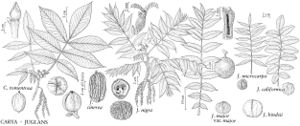Juglans major var. major
Trees, 5-18 m. Bark light to medium gray or brownish, divided into narrow checkered plates. Twigs with distal edge of leaf-scar notched, glabrous or bordered by poorly defined velvety zone; pith brown. Terminal buds narrowly ovoid or conic, flattened, 4-7 mm. Leaves 18-38 cm; petiole 3-6 cm. Leaflets 9-15, lanceolate to lanceovate, symmetric or falcate, 6.5-10.5 × 1.5-3.4 cm, margins serrate, apex narrowly acuminate; surfaces abaxially with capitate-glandular hairs, simple or 2-4-rayed fasciculate hairs, and often scales scattered over veins and blade, axils of proximal veins with prominent tufts of fasciculate hairs, adaxially with capitate-glandular hairs, sometimes also scattered fasciculate hairs, becoming glabrate except along major veins; terminal leaflet usually small or none. Staminate catkins 5-8 cm; stamens 20-40 per flower; pollen-sacs 1.2-1.4 mm. Fruits 1-3, subglobose or short-ovoid, 2-3.5 cm, smooth, densely covered with capitate-glandular hairs and peltate scales, when very immature also fasciculate hairs; nuts globose to ovoid, 1.8-2.7 cm, deeply longitudinally grooved, surfaces between grooves smooth.
Phenology: Flowering spring (Apr–May).
Habitat: Along streams and rocky canyon sides
Elevation: 300-2100 m
Distribution

Ariz., N.Mex., Okla., Tex., Mexico (Chihuahua), Mexico (Durango), Mexico (Sinaloa), Mexico (and Sonora)
Discussion
Specimens intermediate between Juglans major and both J. microcarpa and J. nigra are discussed under the latter species.
Selected References
None.
